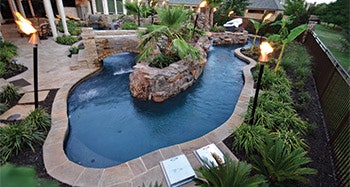It's interesting what can happen when you communicate with a mass audience. Over the years I've authored scores of magazine articles and columns and produced more than 100 YouTube videos featuring my work. From that experience, I've learned you can never fully anticipate the response.
Sometimes you think that a discussion will draw great attention, only to be greeted by the proverbial crickets. Other times, a seemingly innocuous article will garner all sorts of buzz and almost take on a life of its own. The latter was certainly the case with AQUA's "A River Runs Through It," which, along with a video of me riding around in the river, powered by Riverflow Pumps by Current Systems, went viral. Almost by accident, I became associated with lazy rivers and climbed near the top of Google searches on the subject.
RELATED: A River Runs Through It
Almost every week since the article and video went public, I've received calls from people all over the U.S. and abroad who are either in the planning stages of installing a lazy river or, unfortunately, have already installed one that doesn't work.
Although I've been surprised by the response, I'm certainly not complaining. After all, helping people realize their aquatic dreams is what this work is all about.
WHY SO POPULAR
 Much to my surprise, coverage of this project went 'viral' leading to a wave of interest and inquiries from contactors and homeowners looking to install a lazy river of their own. (Photo courtesy of Claffey Pools)
Much to my surprise, coverage of this project went 'viral' leading to a wave of interest and inquiries from contactors and homeowners looking to install a lazy river of their own. (Photo courtesy of Claffey Pools)
To briefly recap, the original article was about making an extremely complex project work in a relatively small space. The effort was achieved with the powerful yet adaptable Riverflow Pumps by Current Systems to provide the current. I've long believed that working in tight confines is arguably one of, it not the biggest challenge pool builders can face, and that particular project was an extreme example of the principle.
Not only did it include the 155-foot river, the project also featured an elaborate island, grotto, two bridges, multiple water features, fire elements, decks and lush landscaping — all squeezed into an average-size backyard. As a result, we had to make use of literally every square inch. There was no room to spare.
It was a huge challenge from both a technical and aesthetic standpoint, which Riverflow Pumps by Current Systems helped alleviate flat grating and compact horsepower — and by the end, a tremendous learning experience as well. I knew we were working with a solid design concept, but even I was somewhat surprised by how well it turned out when completed. Going forward, I am confident that if we can make that design work in such a tight space, we can execute a lazy river almost anywhere.
 Over the past three years I've received numerous calls from people who have projects that have gone wrong. One of the most common mistakes is underestimating the plumbing size and required pumping power.
Over the past three years I've received numerous calls from people who have projects that have gone wrong. One of the most common mistakes is underestimating the plumbing size and required pumping power.
As for why exactly that particular project captured so much attention, it's tough to know for sure. My hunch is that because it was in what most people probably perceive as a typical upper-middle-class property, the work was more relatable than projects that unfold on huge properties for super wealthy clients.
I think much of the appeal simply came down to the fact that many people saw that project and thought, "If this homeowner can make it happen, so can I."
The other factor, I think, was that the design really works visually and functionally. Even though it's in a tight space, the yard looks terrific and the view unfolds as you ride around in it. One of my favorite aspects of landscape design is the "conceal and reveal," which requires strategically organizing the space so you can't see everything at once.
Lazy rivers can provide that kind of opportunity to create a powerful sense of discovery. In this case, every turn and focal point offers a different view. As you ride around the river, you feel as though you are on a journey, all from the comfort of the backyard.
 Photos courtesy of Claffey Pools
Photos courtesy of Claffey Pools
Finally, I think that lazy rivers inherently appeal to certain people. There's a panache and sense of excitement you can't find in static water. You get to move around without exerting any effort. On the other hand, if you want to work out, swimming or walking against the current provides a wonderful form of exercise. Lazy rivers appeal to people of all ages and have a tremendous capacity for bringing and keeping people together.
It's common for homeowners to fixate on a particular water feature after experiencing one on a vacation or a trip to the local waterpark — and that's certainly the case with the lazy river. The price tag will make some people reassess that desire; make no mistake, these are expensive compared to other types of pools. Yet many people are so enamored of the experience, they are happy to devote the resources needed to make it happen.
GOING WITH THE FLOW
 One of the fun aspects of designing a lazy river is the mystery and intrigue you can create, at night and during the day.
One of the fun aspects of designing a lazy river is the mystery and intrigue you can create, at night and during the day.
When I first became involved with the homeowner, I was skeptical that a lazy river was the right direction for his project. He was single and middle-aged, and I wondered why he would be interested in a backyard waterpark.
As it turned out, he wanted the space to serve as a magnet for his grandkids. I asked him a couple years later how that worked out; he reported that it was a huge success with the kids and others. The space is has been a wonderful venue for family time and socializing. He's even hosted three weddings there, including his own.
Lazy rivers offer a strong example of why we shouldn't ever make assumptions about what prospective clients are willing to pay. I've learned not to be afraid to present an ambitious idea and allow the homeowners to figure out for themselves how they want to spend their money.
COMING TO FRUITION
 The 'current' of interest has led to a number of project and potential projects, like this one designed by my co-workers and colleagues a Claffey Pools, Duff Hennessy and Brian Claffey. (Click to Enlarge)
The 'current' of interest has led to a number of project and potential projects, like this one designed by my co-workers and colleagues a Claffey Pools, Duff Hennessy and Brian Claffey. (Click to Enlarge)
We are currently planning new lazy river projects, one of which is set to break ground in the spring. It's a classic example of what can happen as you work with homeowners with an open mind. Like many clients, these people wanted a place for family fun.
Our first design featured a 35-foot lazy river course that branched off from the main part of the pool. After thinking it over, they wanted to find out what it would cost to build a longer river. So I redesigned the project to include a 65-foot river, using the Riverflow Pumps, with a larger island. They loved it and are set to see their fantasy backyard become reality. It includes a slide as well as the river and a host of other features. It's going to be a great project.
As I mentioned above, not all the situations are so upbeat. There have been a number of calls from both homeowners and contractors looking for help with systems that do not perform up to expectations. Having gone through the process of designing and building these things, I have to admit it can be kind of shocking how far off the mark some people can be.
In one case, I heard from a contractor who was puzzled why his nearly 300-foot river wouldn't move anyone. He explained that he had five Pentair Whisperflo pumps on two-inch plumbing. With all of those pumps, he couldn't understand why the system didn't work. He explained that he believed they were moving six feet per second and said they knew this because they threw a stick in the pool and measured how far it traveled in a second.
He was more than a bit surprised when I told him that I used more than double the pumping power with the Riverflow Pumps for a river that was half as long as his, and that was on 12-inch plumbing. And I explained that his floating-stick test was not how you determine flow rate. The only solution I could recommend was to remodel the pool to include properly sized pumps, probably four by my rough estimate, in excess of 10 horsepower each.
In other situations, I've seen projects that not only have inadequate pumping power, but the vessels themselves are not properly shaped to support that lazy river effect.
DOWN THE LINE
If there's a cautionary tale in these scenarios, it's that you really do need to have someone in the loop from the start that has experience with these systems. The guys at Riverflow Pumps by Current Systems really provide that knowledge of their product and all of the applications it has. In this case, the power and compact nature of those pumps have been the driving force for this and other successful residential lazy river projects. It is the very reasons we are using them in future projects. Because if you don't, there's a good chance the river won't run, or instead flows inconsistently, and the homeowners will wind up spending large sums of money on something that doesn't work. And no one benefits when the river doesn't live up to the homeowner's expectations.
This entire situation has been quite the learning experience, both from a technical standpoint — discovering the fine points of lazy river work — but also from the standpoint of self-promotion.
Thanks to this project, I've learned just how powerful today's media can be when it comes to drawing attention to your work, especially when you're communicating a message that stirs the imagination.
Comments or thoughts on this article? Please e-mail [email protected].











































